Analysis of Globalisation, FDI, and Product Life Cycle Dynamics
VerifiedAdded on 2020/06/04
|13
|3946
|105
Report
AI Summary
This report delves into the multifaceted concept of globalisation, examining its influence on international trade, foreign direct investment (FDI), and business operations. It explores the dynamics of globalisation, including technological advancements, trade liberalisation, and the flow of goods and services. The report analyses the current trends of FDI, highlighting the role of multinational corporations (MNCs) in economic growth and the impact on host countries. It also discusses the benefits and costs associated with globalisation. Furthermore, the report examines Vernon's product life cycle model, outlining its stages and limitations, and explores the eclectic paradigm framework for FDI. The analysis covers various aspects of international business, providing a comprehensive understanding of how globalisation shapes organisational strategies and market dynamics, and how it influences business decisions. The report also looks at the benefits and costs of globalisation, providing a detailed view of the subject matter.
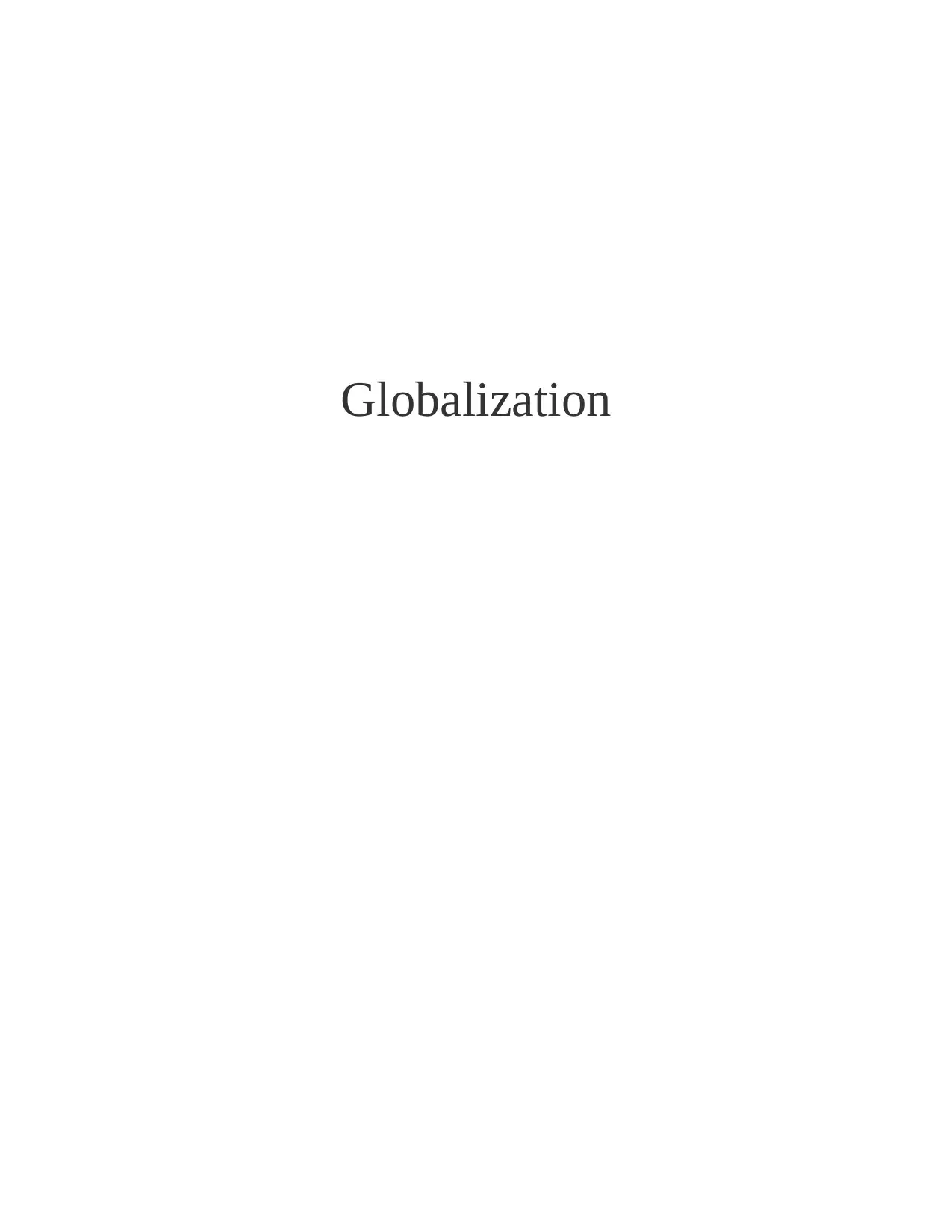
Globalization
Paraphrase This Document
Need a fresh take? Get an instant paraphrase of this document with our AI Paraphraser
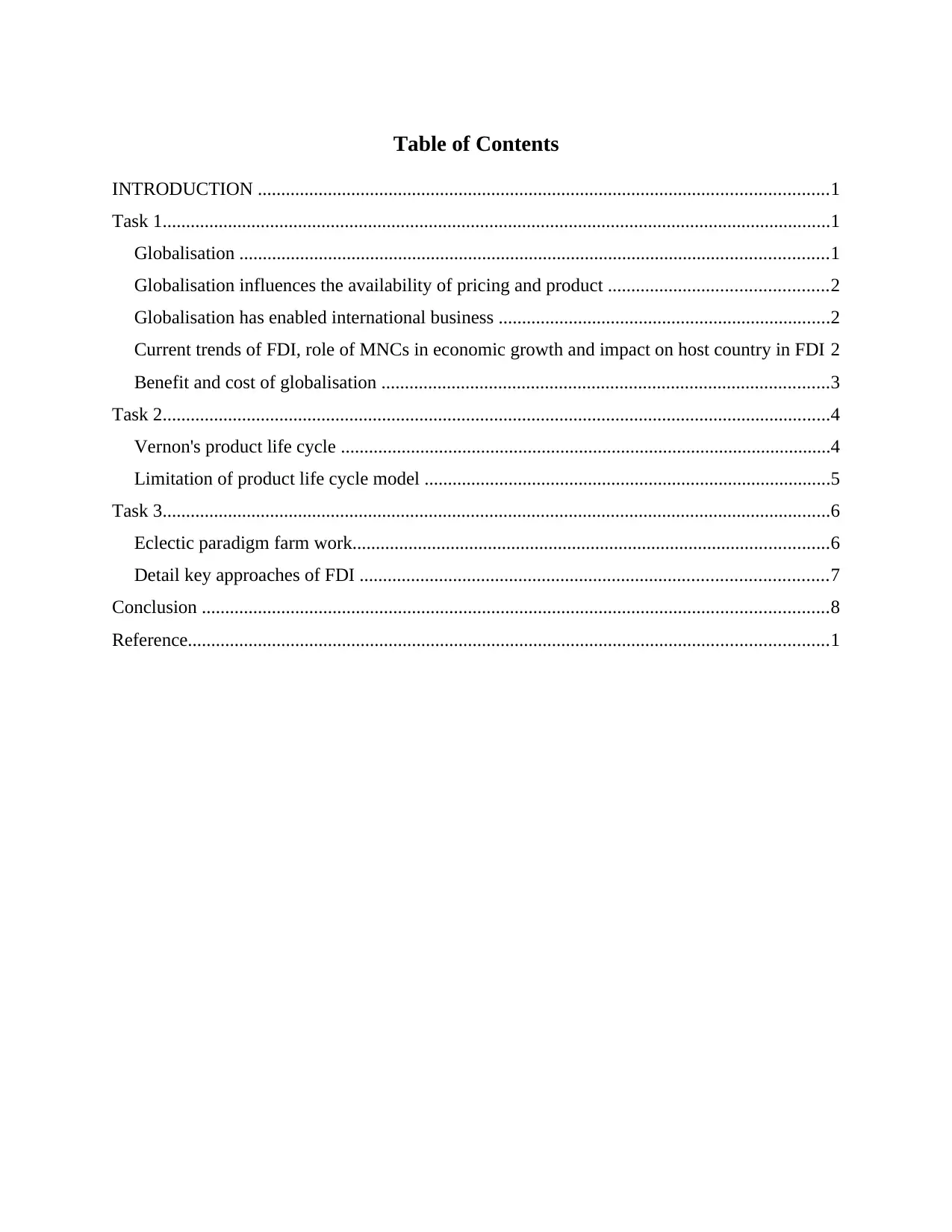
Table of Contents
INTRODUCTION ..........................................................................................................................1
Task 1...............................................................................................................................................1
Globalisation ..............................................................................................................................1
Globalisation influences the availability of pricing and product ...............................................2
Globalisation has enabled international business .......................................................................2
Current trends of FDI, role of MNCs in economic growth and impact on host country in FDI 2
Benefit and cost of globalisation ................................................................................................3
Task 2...............................................................................................................................................4
Vernon's product life cycle .........................................................................................................4
Limitation of product life cycle model .......................................................................................5
Task 3...............................................................................................................................................6
Eclectic paradigm farm work......................................................................................................6
Detail key approaches of FDI ....................................................................................................7
Conclusion ......................................................................................................................................8
Reference.........................................................................................................................................1
INTRODUCTION ..........................................................................................................................1
Task 1...............................................................................................................................................1
Globalisation ..............................................................................................................................1
Globalisation influences the availability of pricing and product ...............................................2
Globalisation has enabled international business .......................................................................2
Current trends of FDI, role of MNCs in economic growth and impact on host country in FDI 2
Benefit and cost of globalisation ................................................................................................3
Task 2...............................................................................................................................................4
Vernon's product life cycle .........................................................................................................4
Limitation of product life cycle model .......................................................................................5
Task 3...............................................................................................................................................6
Eclectic paradigm farm work......................................................................................................6
Detail key approaches of FDI ....................................................................................................7
Conclusion ......................................................................................................................................8
Reference.........................................................................................................................................1
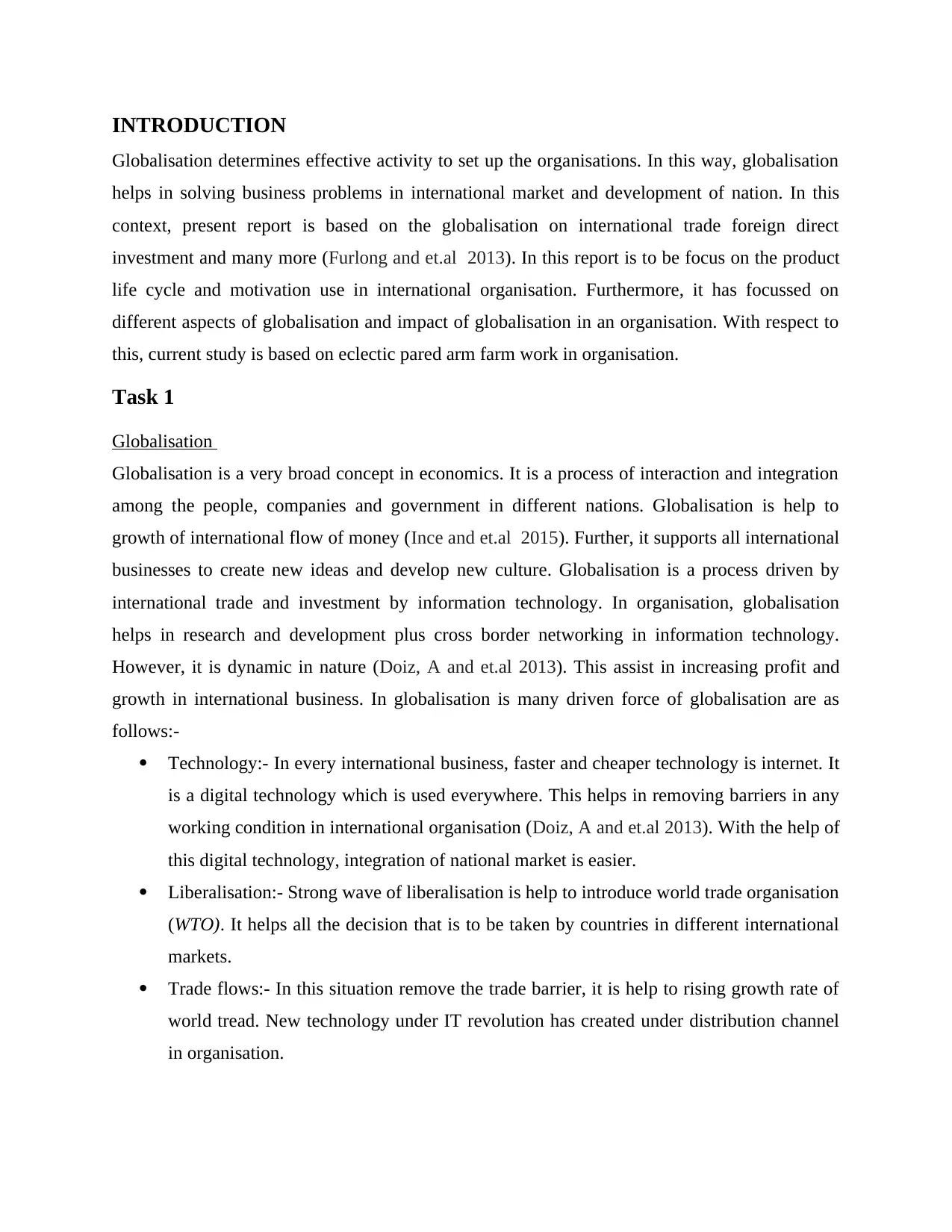
INTRODUCTION
Globalisation determines effective activity to set up the organisations. In this way, globalisation
helps in solving business problems in international market and development of nation. In this
context, present report is based on the globalisation on international trade foreign direct
investment and many more (Furlong and et.al 2013). In this report is to be focus on the product
life cycle and motivation use in international organisation. Furthermore, it has focussed on
different aspects of globalisation and impact of globalisation in an organisation. With respect to
this, current study is based on eclectic pared arm farm work in organisation.
Task 1
Globalisation
Globalisation is a very broad concept in economics. It is a process of interaction and integration
among the people, companies and government in different nations. Globalisation is help to
growth of international flow of money (Ince and et.al 2015). Further, it supports all international
businesses to create new ideas and develop new culture. Globalisation is a process driven by
international trade and investment by information technology. In organisation, globalisation
helps in research and development plus cross border networking in information technology.
However, it is dynamic in nature (Doiz, A and et.al 2013). This assist in increasing profit and
growth in international business. In globalisation is many driven force of globalisation are as
follows:-
Technology:- In every international business, faster and cheaper technology is internet. It
is a digital technology which is used everywhere. This helps in removing barriers in any
working condition in international organisation (Doiz, A and et.al 2013). With the help of
this digital technology, integration of national market is easier.
Liberalisation:- Strong wave of liberalisation is help to introduce world trade organisation
(WTO). It helps all the decision that is to be taken by countries in different international
markets.
Trade flows:- In this situation remove the trade barrier, it is help to rising growth rate of
world tread. New technology under IT revolution has created under distribution channel
in organisation.
Globalisation determines effective activity to set up the organisations. In this way, globalisation
helps in solving business problems in international market and development of nation. In this
context, present report is based on the globalisation on international trade foreign direct
investment and many more (Furlong and et.al 2013). In this report is to be focus on the product
life cycle and motivation use in international organisation. Furthermore, it has focussed on
different aspects of globalisation and impact of globalisation in an organisation. With respect to
this, current study is based on eclectic pared arm farm work in organisation.
Task 1
Globalisation
Globalisation is a very broad concept in economics. It is a process of interaction and integration
among the people, companies and government in different nations. Globalisation is help to
growth of international flow of money (Ince and et.al 2015). Further, it supports all international
businesses to create new ideas and develop new culture. Globalisation is a process driven by
international trade and investment by information technology. In organisation, globalisation
helps in research and development plus cross border networking in information technology.
However, it is dynamic in nature (Doiz, A and et.al 2013). This assist in increasing profit and
growth in international business. In globalisation is many driven force of globalisation are as
follows:-
Technology:- In every international business, faster and cheaper technology is internet. It
is a digital technology which is used everywhere. This helps in removing barriers in any
working condition in international organisation (Doiz, A and et.al 2013). With the help of
this digital technology, integration of national market is easier.
Liberalisation:- Strong wave of liberalisation is help to introduce world trade organisation
(WTO). It helps all the decision that is to be taken by countries in different international
markets.
Trade flows:- In this situation remove the trade barrier, it is help to rising growth rate of
world tread. New technology under IT revolution has created under distribution channel
in organisation.
⊘ This is a preview!⊘
Do you want full access?
Subscribe today to unlock all pages.

Trusted by 1+ million students worldwide
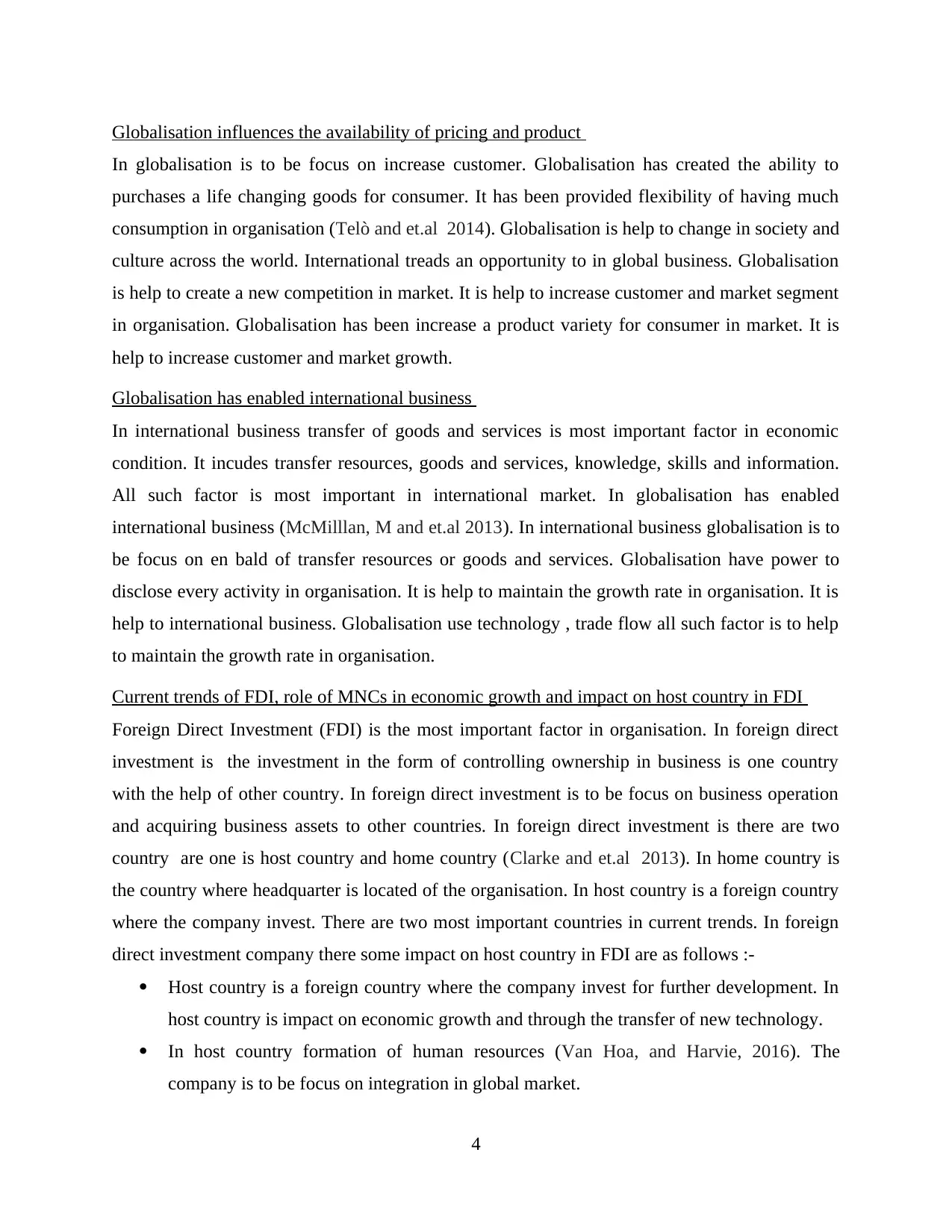
Globalisation influences the availability of pricing and product
In globalisation is to be focus on increase customer. Globalisation has created the ability to
purchases a life changing goods for consumer. It has been provided flexibility of having much
consumption in organisation (Telò and et.al 2014). Globalisation is help to change in society and
culture across the world. International treads an opportunity to in global business. Globalisation
is help to create a new competition in market. It is help to increase customer and market segment
in organisation. Globalisation has been increase a product variety for consumer in market. It is
help to increase customer and market growth.
Globalisation has enabled international business
In international business transfer of goods and services is most important factor in economic
condition. It incudes transfer resources, goods and services, knowledge, skills and information.
All such factor is most important in international market. In globalisation has enabled
international business (McMilllan, M and et.al 2013). In international business globalisation is to
be focus on en bald of transfer resources or goods and services. Globalisation have power to
disclose every activity in organisation. It is help to maintain the growth rate in organisation. It is
help to international business. Globalisation use technology , trade flow all such factor is to help
to maintain the growth rate in organisation.
Current trends of FDI, role of MNCs in economic growth and impact on host country in FDI
Foreign Direct Investment (FDI) is the most important factor in organisation. In foreign direct
investment is the investment in the form of controlling ownership in business is one country
with the help of other country. In foreign direct investment is to be focus on business operation
and acquiring business assets to other countries. In foreign direct investment is there are two
country are one is host country and home country (Clarke and et.al 2013). In home country is
the country where headquarter is located of the organisation. In host country is a foreign country
where the company invest. There are two most important countries in current trends. In foreign
direct investment company there some impact on host country in FDI are as follows :-
Host country is a foreign country where the company invest for further development. In
host country is impact on economic growth and through the transfer of new technology.
In host country formation of human resources (Van Hoa, and Harvie, 2016). The
company is to be focus on integration in global market.
4
In globalisation is to be focus on increase customer. Globalisation has created the ability to
purchases a life changing goods for consumer. It has been provided flexibility of having much
consumption in organisation (Telò and et.al 2014). Globalisation is help to change in society and
culture across the world. International treads an opportunity to in global business. Globalisation
is help to create a new competition in market. It is help to increase customer and market segment
in organisation. Globalisation has been increase a product variety for consumer in market. It is
help to increase customer and market growth.
Globalisation has enabled international business
In international business transfer of goods and services is most important factor in economic
condition. It incudes transfer resources, goods and services, knowledge, skills and information.
All such factor is most important in international market. In globalisation has enabled
international business (McMilllan, M and et.al 2013). In international business globalisation is to
be focus on en bald of transfer resources or goods and services. Globalisation have power to
disclose every activity in organisation. It is help to maintain the growth rate in organisation. It is
help to international business. Globalisation use technology , trade flow all such factor is to help
to maintain the growth rate in organisation.
Current trends of FDI, role of MNCs in economic growth and impact on host country in FDI
Foreign Direct Investment (FDI) is the most important factor in organisation. In foreign direct
investment is the investment in the form of controlling ownership in business is one country
with the help of other country. In foreign direct investment is to be focus on business operation
and acquiring business assets to other countries. In foreign direct investment is there are two
country are one is host country and home country (Clarke and et.al 2013). In home country is
the country where headquarter is located of the organisation. In host country is a foreign country
where the company invest. There are two most important countries in current trends. In foreign
direct investment company there some impact on host country in FDI are as follows :-
Host country is a foreign country where the company invest for further development. In
host country is impact on economic growth and through the transfer of new technology.
In host country formation of human resources (Van Hoa, and Harvie, 2016). The
company is to be focus on integration in global market.
4
Paraphrase This Document
Need a fresh take? Get an instant paraphrase of this document with our AI Paraphraser
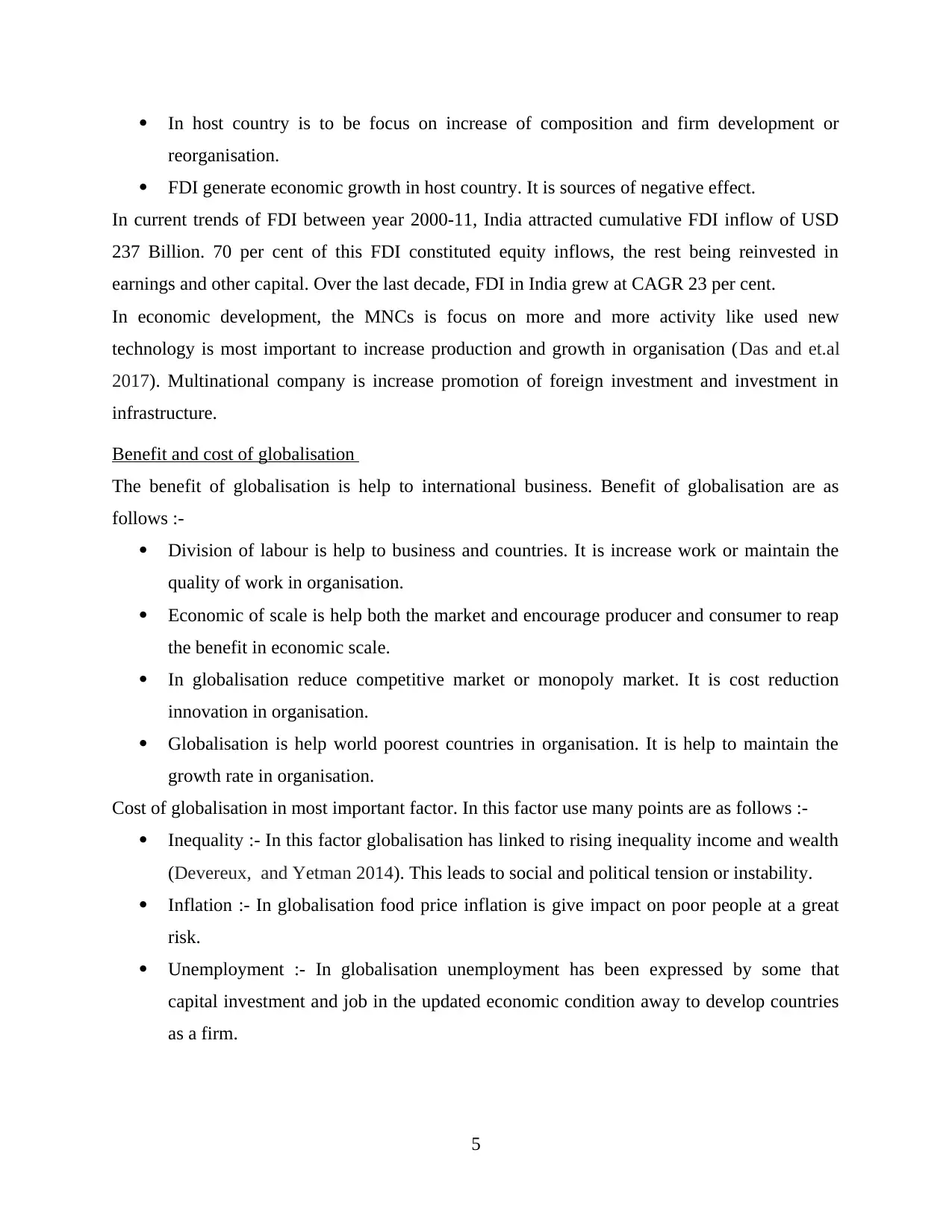
In host country is to be focus on increase of composition and firm development or
reorganisation.
FDI generate economic growth in host country. It is sources of negative effect.
In current trends of FDI between year 2000-11, India attracted cumulative FDI inflow of USD
237 Billion. 70 per cent of this FDI constituted equity inflows, the rest being reinvested in
earnings and other capital. Over the last decade, FDI in India grew at CAGR 23 per cent.
In economic development, the MNCs is focus on more and more activity like used new
technology is most important to increase production and growth in organisation (Das and et.al
2017). Multinational company is increase promotion of foreign investment and investment in
infrastructure.
Benefit and cost of globalisation
The benefit of globalisation is help to international business. Benefit of globalisation are as
follows :-
Division of labour is help to business and countries. It is increase work or maintain the
quality of work in organisation.
Economic of scale is help both the market and encourage producer and consumer to reap
the benefit in economic scale.
In globalisation reduce competitive market or monopoly market. It is cost reduction
innovation in organisation.
Globalisation is help world poorest countries in organisation. It is help to maintain the
growth rate in organisation.
Cost of globalisation in most important factor. In this factor use many points are as follows :-
Inequality :- In this factor globalisation has linked to rising inequality income and wealth
(Devereux, and Yetman 2014). This leads to social and political tension or instability.
Inflation :- In globalisation food price inflation is give impact on poor people at a great
risk.
Unemployment :- In globalisation unemployment has been expressed by some that
capital investment and job in the updated economic condition away to develop countries
as a firm.
5
reorganisation.
FDI generate economic growth in host country. It is sources of negative effect.
In current trends of FDI between year 2000-11, India attracted cumulative FDI inflow of USD
237 Billion. 70 per cent of this FDI constituted equity inflows, the rest being reinvested in
earnings and other capital. Over the last decade, FDI in India grew at CAGR 23 per cent.
In economic development, the MNCs is focus on more and more activity like used new
technology is most important to increase production and growth in organisation (Das and et.al
2017). Multinational company is increase promotion of foreign investment and investment in
infrastructure.
Benefit and cost of globalisation
The benefit of globalisation is help to international business. Benefit of globalisation are as
follows :-
Division of labour is help to business and countries. It is increase work or maintain the
quality of work in organisation.
Economic of scale is help both the market and encourage producer and consumer to reap
the benefit in economic scale.
In globalisation reduce competitive market or monopoly market. It is cost reduction
innovation in organisation.
Globalisation is help world poorest countries in organisation. It is help to maintain the
growth rate in organisation.
Cost of globalisation in most important factor. In this factor use many points are as follows :-
Inequality :- In this factor globalisation has linked to rising inequality income and wealth
(Devereux, and Yetman 2014). This leads to social and political tension or instability.
Inflation :- In globalisation food price inflation is give impact on poor people at a great
risk.
Unemployment :- In globalisation unemployment has been expressed by some that
capital investment and job in the updated economic condition away to develop countries
as a firm.
5

Task 2
Vernon's product life cycle
Product life cycle is used four different stage to start a new business. In product life-cycle theory
is developed by the Raymond Vernon. It is also called as economic theory. In product life cycle
is help to every stage of production.
This PLC theory is defined the products were not standardized as the nature of goods has
implantation such as a price elastic, the communication throughout the industry and also focus
on location of product (King and et.al 2016). All this factor is most important at the time of new
product lunch in market. In product life cycle is also focus on the demand of the product in
organisation. In product life cycle is use four different stages are as follows :-
Introduction :- In this stage new product are introduced to meet local needs. In
introduction stage new product are to be exported in similar country. It incudes countries
with similar needs and wants in market. In introduction stage company is to be focus on
need, preferences and income of the consumer. This three factor is most important in
introduction stages (Zajda and et.al 2015). It helps at the time of introduce new product
in market. In introduce stage is focus on monopoly market in U.S. In this first stage U.S.
Produce have monopoly in export market. This market focus on build up sale in with no
encore on foreign economic market.
Growth :- This is a second stage of product life cycle. In this stage company may use
some innovative things for help in growth of the product in market. In this second stage
produce industrial product and manufacturing product are design and implanter in
market. It is focus on the overall growth of the U.S. Market decline (Beech, and Rizvi,
2017). In this stage product life cycle model on international trade for innovating
countries for example united state and imaginary countries like Germany and Mexico.
There are the best example in second stage in organisation.
Mature product :- In this stage is to be focus on different aspects of market. In this stage
the product is increase market growth and share in organisation. It is help to increase
profit in organisation (Filippidis and et.al 2017). In this stage company product is top in
the market. In this stage is to be focus on to maintain the growth rate of the product in
market. It is help to use different stages in organisation performance and maintain it on
6
Vernon's product life cycle
Product life cycle is used four different stage to start a new business. In product life-cycle theory
is developed by the Raymond Vernon. It is also called as economic theory. In product life cycle
is help to every stage of production.
This PLC theory is defined the products were not standardized as the nature of goods has
implantation such as a price elastic, the communication throughout the industry and also focus
on location of product (King and et.al 2016). All this factor is most important at the time of new
product lunch in market. In product life cycle is also focus on the demand of the product in
organisation. In product life cycle is use four different stages are as follows :-
Introduction :- In this stage new product are introduced to meet local needs. In
introduction stage new product are to be exported in similar country. It incudes countries
with similar needs and wants in market. In introduction stage company is to be focus on
need, preferences and income of the consumer. This three factor is most important in
introduction stages (Zajda and et.al 2015). It helps at the time of introduce new product
in market. In introduce stage is focus on monopoly market in U.S. In this first stage U.S.
Produce have monopoly in export market. This market focus on build up sale in with no
encore on foreign economic market.
Growth :- This is a second stage of product life cycle. In this stage company may use
some innovative things for help in growth of the product in market. In this second stage
produce industrial product and manufacturing product are design and implanter in
market. It is focus on the overall growth of the U.S. Market decline (Beech, and Rizvi,
2017). In this stage product life cycle model on international trade for innovating
countries for example united state and imaginary countries like Germany and Mexico.
There are the best example in second stage in organisation.
Mature product :- In this stage is to be focus on different aspects of market. In this stage
the product is increase market growth and share in organisation. It is help to increase
profit in organisation (Filippidis and et.al 2017). In this stage company product is top in
the market. In this stage is to be focus on to maintain the growth rate of the product in
market. It is help to use different stages in organisation performance and maintain it on
6
⊘ This is a preview!⊘
Do you want full access?
Subscribe today to unlock all pages.

Trusted by 1+ million students worldwide
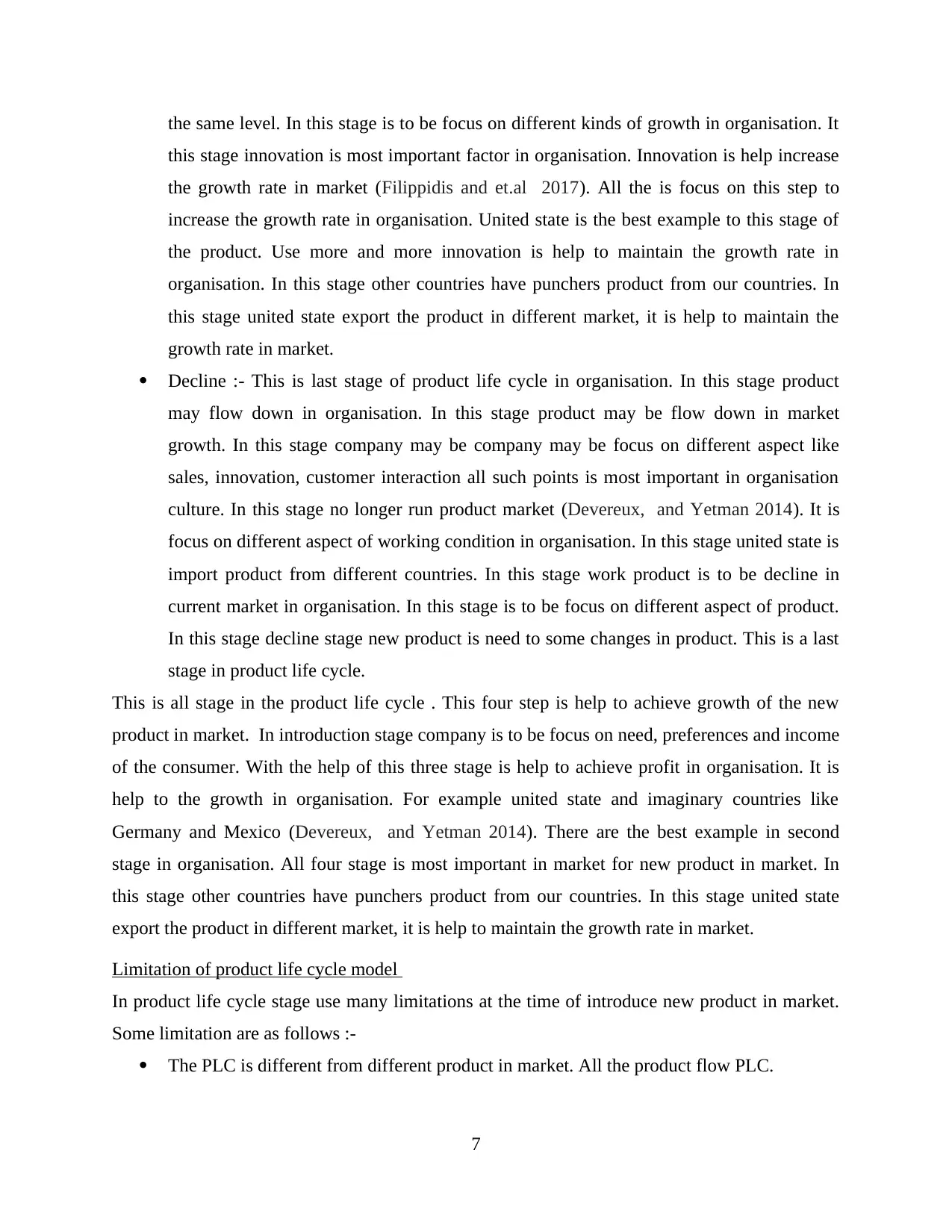
the same level. In this stage is to be focus on different kinds of growth in organisation. It
this stage innovation is most important factor in organisation. Innovation is help increase
the growth rate in market (Filippidis and et.al 2017). All the is focus on this step to
increase the growth rate in organisation. United state is the best example to this stage of
the product. Use more and more innovation is help to maintain the growth rate in
organisation. In this stage other countries have punchers product from our countries. In
this stage united state export the product in different market, it is help to maintain the
growth rate in market.
Decline :- This is last stage of product life cycle in organisation. In this stage product
may flow down in organisation. In this stage product may be flow down in market
growth. In this stage company may be company may be focus on different aspect like
sales, innovation, customer interaction all such points is most important in organisation
culture. In this stage no longer run product market (Devereux, and Yetman 2014). It is
focus on different aspect of working condition in organisation. In this stage united state is
import product from different countries. In this stage work product is to be decline in
current market in organisation. In this stage is to be focus on different aspect of product.
In this stage decline stage new product is need to some changes in product. This is a last
stage in product life cycle.
This is all stage in the product life cycle . This four step is help to achieve growth of the new
product in market. In introduction stage company is to be focus on need, preferences and income
of the consumer. With the help of this three stage is help to achieve profit in organisation. It is
help to the growth in organisation. For example united state and imaginary countries like
Germany and Mexico (Devereux, and Yetman 2014). There are the best example in second
stage in organisation. All four stage is most important in market for new product in market. In
this stage other countries have punchers product from our countries. In this stage united state
export the product in different market, it is help to maintain the growth rate in market.
Limitation of product life cycle model
In product life cycle stage use many limitations at the time of introduce new product in market.
Some limitation are as follows :-
The PLC is different from different product in market. All the product flow PLC.
7
this stage innovation is most important factor in organisation. Innovation is help increase
the growth rate in market (Filippidis and et.al 2017). All the is focus on this step to
increase the growth rate in organisation. United state is the best example to this stage of
the product. Use more and more innovation is help to maintain the growth rate in
organisation. In this stage other countries have punchers product from our countries. In
this stage united state export the product in different market, it is help to maintain the
growth rate in market.
Decline :- This is last stage of product life cycle in organisation. In this stage product
may flow down in organisation. In this stage product may be flow down in market
growth. In this stage company may be company may be focus on different aspect like
sales, innovation, customer interaction all such points is most important in organisation
culture. In this stage no longer run product market (Devereux, and Yetman 2014). It is
focus on different aspect of working condition in organisation. In this stage united state is
import product from different countries. In this stage work product is to be decline in
current market in organisation. In this stage is to be focus on different aspect of product.
In this stage decline stage new product is need to some changes in product. This is a last
stage in product life cycle.
This is all stage in the product life cycle . This four step is help to achieve growth of the new
product in market. In introduction stage company is to be focus on need, preferences and income
of the consumer. With the help of this three stage is help to achieve profit in organisation. It is
help to the growth in organisation. For example united state and imaginary countries like
Germany and Mexico (Devereux, and Yetman 2014). There are the best example in second
stage in organisation. All four stage is most important in market for new product in market. In
this stage other countries have punchers product from our countries. In this stage united state
export the product in different market, it is help to maintain the growth rate in market.
Limitation of product life cycle model
In product life cycle stage use many limitations at the time of introduce new product in market.
Some limitation are as follows :-
The PLC is different from different product in market. All the product flow PLC.
7
Paraphrase This Document
Need a fresh take? Get an instant paraphrase of this document with our AI Paraphraser
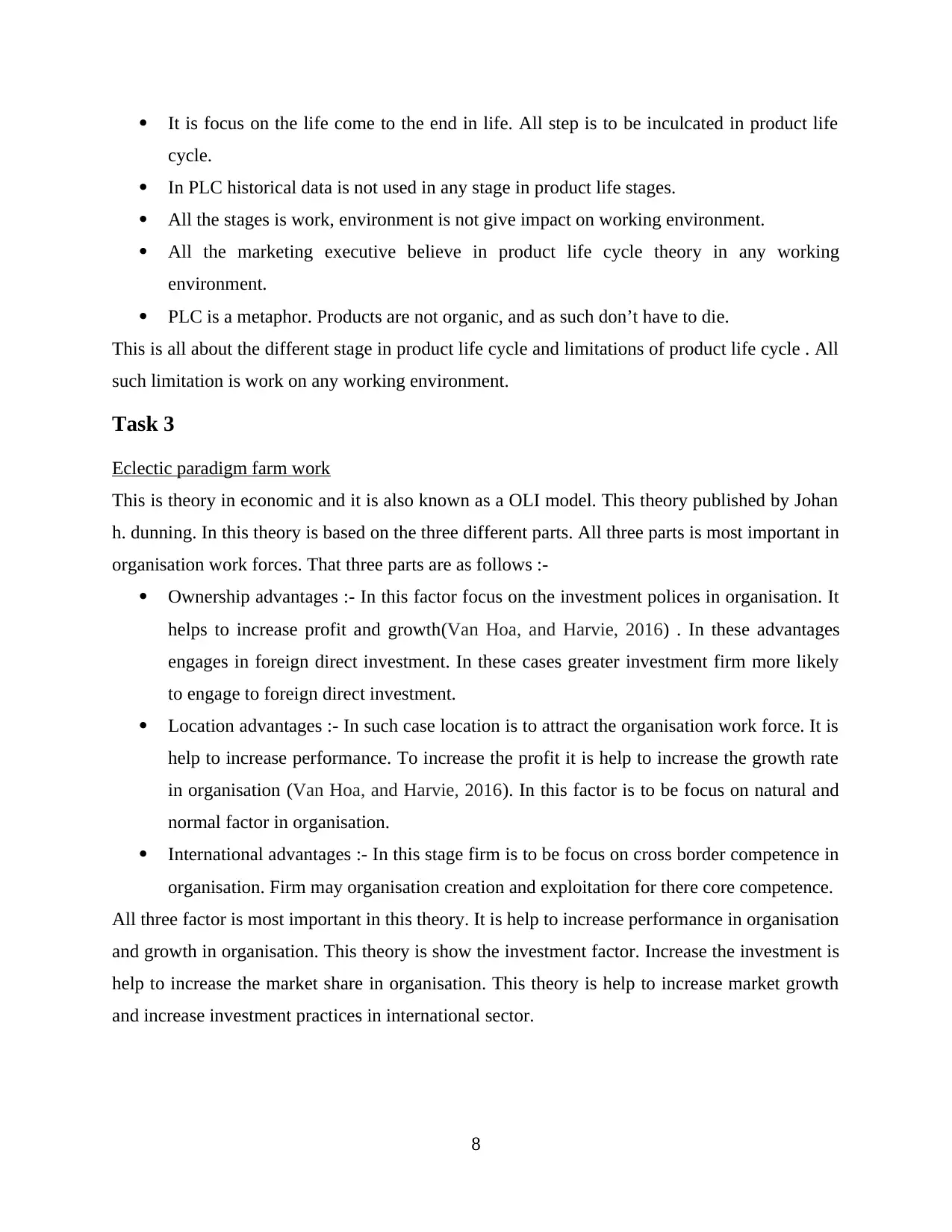
It is focus on the life come to the end in life. All step is to be inculcated in product life
cycle.
In PLC historical data is not used in any stage in product life stages.
All the stages is work, environment is not give impact on working environment.
All the marketing executive believe in product life cycle theory in any working
environment.
PLC is a metaphor. Products are not organic, and as such don’t have to die.
This is all about the different stage in product life cycle and limitations of product life cycle . All
such limitation is work on any working environment.
Task 3
Eclectic paradigm farm work
This is theory in economic and it is also known as a OLI model. This theory published by Johan
h. dunning. In this theory is based on the three different parts. All three parts is most important in
organisation work forces. That three parts are as follows :-
Ownership advantages :- In this factor focus on the investment polices in organisation. It
helps to increase profit and growth(Van Hoa, and Harvie, 2016) . In these advantages
engages in foreign direct investment. In these cases greater investment firm more likely
to engage to foreign direct investment.
Location advantages :- In such case location is to attract the organisation work force. It is
help to increase performance. To increase the profit it is help to increase the growth rate
in organisation (Van Hoa, and Harvie, 2016). In this factor is to be focus on natural and
normal factor in organisation.
International advantages :- In this stage firm is to be focus on cross border competence in
organisation. Firm may organisation creation and exploitation for there core competence.
All three factor is most important in this theory. It is help to increase performance in organisation
and growth in organisation. This theory is show the investment factor. Increase the investment is
help to increase the market share in organisation. This theory is help to increase market growth
and increase investment practices in international sector.
8
cycle.
In PLC historical data is not used in any stage in product life stages.
All the stages is work, environment is not give impact on working environment.
All the marketing executive believe in product life cycle theory in any working
environment.
PLC is a metaphor. Products are not organic, and as such don’t have to die.
This is all about the different stage in product life cycle and limitations of product life cycle . All
such limitation is work on any working environment.
Task 3
Eclectic paradigm farm work
This is theory in economic and it is also known as a OLI model. This theory published by Johan
h. dunning. In this theory is based on the three different parts. All three parts is most important in
organisation work forces. That three parts are as follows :-
Ownership advantages :- In this factor focus on the investment polices in organisation. It
helps to increase profit and growth(Van Hoa, and Harvie, 2016) . In these advantages
engages in foreign direct investment. In these cases greater investment firm more likely
to engage to foreign direct investment.
Location advantages :- In such case location is to attract the organisation work force. It is
help to increase performance. To increase the profit it is help to increase the growth rate
in organisation (Van Hoa, and Harvie, 2016). In this factor is to be focus on natural and
normal factor in organisation.
International advantages :- In this stage firm is to be focus on cross border competence in
organisation. Firm may organisation creation and exploitation for there core competence.
All three factor is most important in this theory. It is help to increase performance in organisation
and growth in organisation. This theory is show the investment factor. Increase the investment is
help to increase the market share in organisation. This theory is help to increase market growth
and increase investment practices in international sector.
8
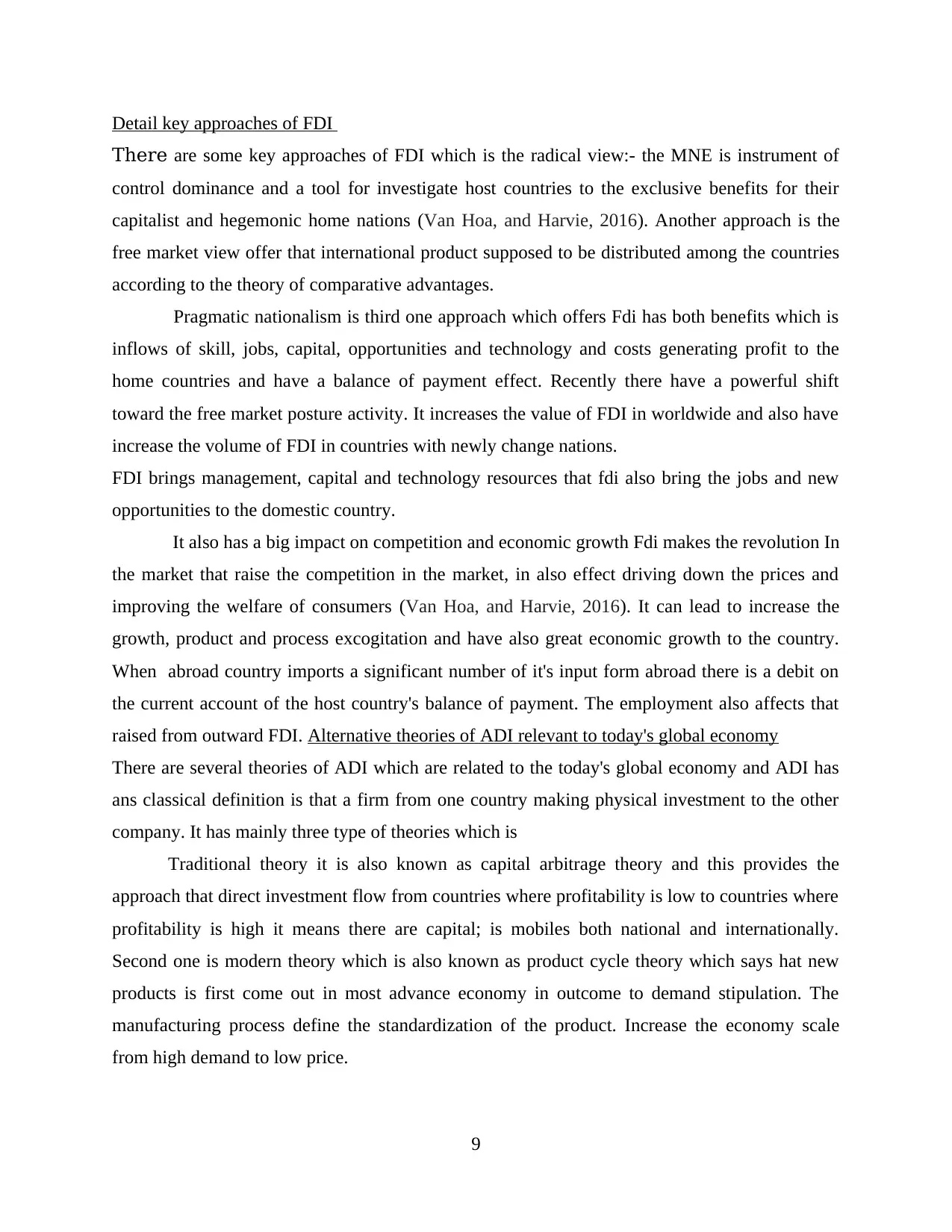
Detail key approaches of FDI
There are some key approaches of FDI which is the radical view:- the MNE is instrument of
control dominance and a tool for investigate host countries to the exclusive benefits for their
capitalist and hegemonic home nations (Van Hoa, and Harvie, 2016). Another approach is the
free market view offer that international product supposed to be distributed among the countries
according to the theory of comparative advantages.
Pragmatic nationalism is third one approach which offers Fdi has both benefits which is
inflows of skill, jobs, capital, opportunities and technology and costs generating profit to the
home countries and have a balance of payment effect. Recently there have a powerful shift
toward the free market posture activity. It increases the value of FDI in worldwide and also have
increase the volume of FDI in countries with newly change nations.
FDI brings management, capital and technology resources that fdi also bring the jobs and new
opportunities to the domestic country.
It also has a big impact on competition and economic growth Fdi makes the revolution In
the market that raise the competition in the market, in also effect driving down the prices and
improving the welfare of consumers (Van Hoa, and Harvie, 2016). It can lead to increase the
growth, product and process excogitation and have also great economic growth to the country.
When abroad country imports a significant number of it's input form abroad there is a debit on
the current account of the host country's balance of payment. The employment also affects that
raised from outward FDI. Alternative theories of ADI relevant to today's global economy
There are several theories of ADI which are related to the today's global economy and ADI has
ans classical definition is that a firm from one country making physical investment to the other
company. It has mainly three type of theories which is
Traditional theory it is also known as capital arbitrage theory and this provides the
approach that direct investment flow from countries where profitability is low to countries where
profitability is high it means there are capital; is mobiles both national and internationally.
Second one is modern theory which is also known as product cycle theory which says hat new
products is first come out in most advance economy in outcome to demand stipulation. The
manufacturing process define the standardization of the product. Increase the economy scale
from high demand to low price.
9
There are some key approaches of FDI which is the radical view:- the MNE is instrument of
control dominance and a tool for investigate host countries to the exclusive benefits for their
capitalist and hegemonic home nations (Van Hoa, and Harvie, 2016). Another approach is the
free market view offer that international product supposed to be distributed among the countries
according to the theory of comparative advantages.
Pragmatic nationalism is third one approach which offers Fdi has both benefits which is
inflows of skill, jobs, capital, opportunities and technology and costs generating profit to the
home countries and have a balance of payment effect. Recently there have a powerful shift
toward the free market posture activity. It increases the value of FDI in worldwide and also have
increase the volume of FDI in countries with newly change nations.
FDI brings management, capital and technology resources that fdi also bring the jobs and new
opportunities to the domestic country.
It also has a big impact on competition and economic growth Fdi makes the revolution In
the market that raise the competition in the market, in also effect driving down the prices and
improving the welfare of consumers (Van Hoa, and Harvie, 2016). It can lead to increase the
growth, product and process excogitation and have also great economic growth to the country.
When abroad country imports a significant number of it's input form abroad there is a debit on
the current account of the host country's balance of payment. The employment also affects that
raised from outward FDI. Alternative theories of ADI relevant to today's global economy
There are several theories of ADI which are related to the today's global economy and ADI has
ans classical definition is that a firm from one country making physical investment to the other
company. It has mainly three type of theories which is
Traditional theory it is also known as capital arbitrage theory and this provides the
approach that direct investment flow from countries where profitability is low to countries where
profitability is high it means there are capital; is mobiles both national and internationally.
Second one is modern theory which is also known as product cycle theory which says hat new
products is first come out in most advance economy in outcome to demand stipulation. The
manufacturing process define the standardization of the product. Increase the economy scale
from high demand to low price.
9
⊘ This is a preview!⊘
Do you want full access?
Subscribe today to unlock all pages.

Trusted by 1+ million students worldwide
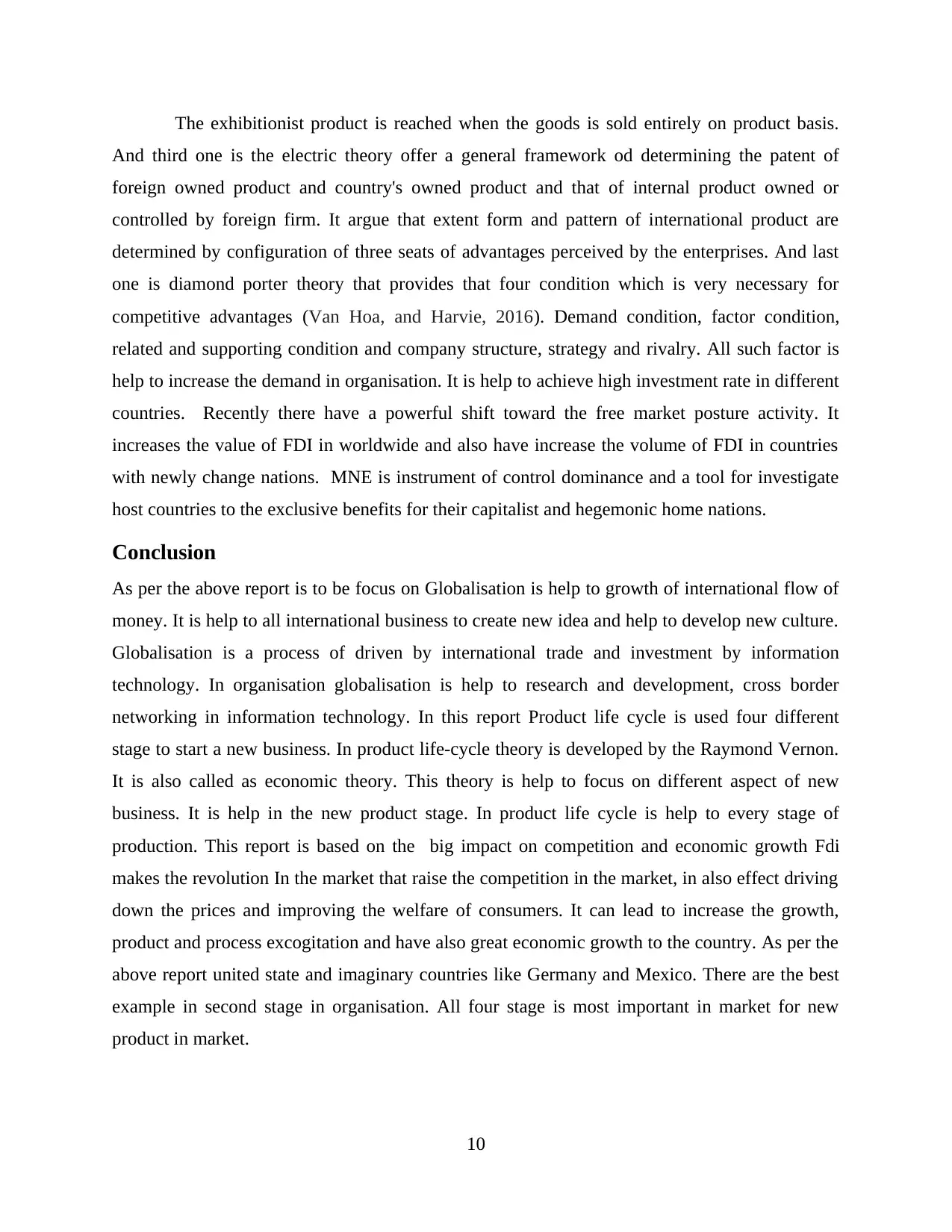
The exhibitionist product is reached when the goods is sold entirely on product basis.
And third one is the electric theory offer a general framework od determining the patent of
foreign owned product and country's owned product and that of internal product owned or
controlled by foreign firm. It argue that extent form and pattern of international product are
determined by configuration of three seats of advantages perceived by the enterprises. And last
one is diamond porter theory that provides that four condition which is very necessary for
competitive advantages (Van Hoa, and Harvie, 2016). Demand condition, factor condition,
related and supporting condition and company structure, strategy and rivalry. All such factor is
help to increase the demand in organisation. It is help to achieve high investment rate in different
countries. Recently there have a powerful shift toward the free market posture activity. It
increases the value of FDI in worldwide and also have increase the volume of FDI in countries
with newly change nations. MNE is instrument of control dominance and a tool for investigate
host countries to the exclusive benefits for their capitalist and hegemonic home nations.
Conclusion
As per the above report is to be focus on Globalisation is help to growth of international flow of
money. It is help to all international business to create new idea and help to develop new culture.
Globalisation is a process of driven by international trade and investment by information
technology. In organisation globalisation is help to research and development, cross border
networking in information technology. In this report Product life cycle is used four different
stage to start a new business. In product life-cycle theory is developed by the Raymond Vernon.
It is also called as economic theory. This theory is help to focus on different aspect of new
business. It is help in the new product stage. In product life cycle is help to every stage of
production. This report is based on the big impact on competition and economic growth Fdi
makes the revolution In the market that raise the competition in the market, in also effect driving
down the prices and improving the welfare of consumers. It can lead to increase the growth,
product and process excogitation and have also great economic growth to the country. As per the
above report united state and imaginary countries like Germany and Mexico. There are the best
example in second stage in organisation. All four stage is most important in market for new
product in market.
10
And third one is the electric theory offer a general framework od determining the patent of
foreign owned product and country's owned product and that of internal product owned or
controlled by foreign firm. It argue that extent form and pattern of international product are
determined by configuration of three seats of advantages perceived by the enterprises. And last
one is diamond porter theory that provides that four condition which is very necessary for
competitive advantages (Van Hoa, and Harvie, 2016). Demand condition, factor condition,
related and supporting condition and company structure, strategy and rivalry. All such factor is
help to increase the demand in organisation. It is help to achieve high investment rate in different
countries. Recently there have a powerful shift toward the free market posture activity. It
increases the value of FDI in worldwide and also have increase the volume of FDI in countries
with newly change nations. MNE is instrument of control dominance and a tool for investigate
host countries to the exclusive benefits for their capitalist and hegemonic home nations.
Conclusion
As per the above report is to be focus on Globalisation is help to growth of international flow of
money. It is help to all international business to create new idea and help to develop new culture.
Globalisation is a process of driven by international trade and investment by information
technology. In organisation globalisation is help to research and development, cross border
networking in information technology. In this report Product life cycle is used four different
stage to start a new business. In product life-cycle theory is developed by the Raymond Vernon.
It is also called as economic theory. This theory is help to focus on different aspect of new
business. It is help in the new product stage. In product life cycle is help to every stage of
production. This report is based on the big impact on competition and economic growth Fdi
makes the revolution In the market that raise the competition in the market, in also effect driving
down the prices and improving the welfare of consumers. It can lead to increase the growth,
product and process excogitation and have also great economic growth to the country. As per the
above report united state and imaginary countries like Germany and Mexico. There are the best
example in second stage in organisation. All four stage is most important in market for new
product in market.
10
Paraphrase This Document
Need a fresh take? Get an instant paraphrase of this document with our AI Paraphraser

Reference
Books and journals
Furlong, J., 2013, January. Globalisation, neoliberalism, and the reform of teacher education in
England. In The educational forum (Vol. 77, No. 1, pp. 28-50). Taylor & Francis Group.
Ince, A and et.al 2015. British jobs for British workers? Negotiating work, nation, and
globalisation through the Lindsey Oil Refinery disputes. Antipode. 47(1), pp.139-157.
Doiz, A and et.al 2013. Globalisation, internationalisation, multilingualism and linguistic strains
in higher education. Studies in higher education, 38(9), pp.1407-1421.
Telò, M., 2014. Globalisation, Multilateralism, Europe: Towards a Better Global Governance?
(Globalisation, Europe, Multilateralism Series). Ashgate Publishing Group.
McMilllan, M and et.al 2013. Globalisation, structural change, and productivity growth, with an
update on Africa. Lilongwe, Malawi: IFPRI.
Clarke, T., 2013. The advance of the MOOCs (massive open online courses) The impending
globalisation of business education?. Education+ Training. 55(4/5). pp.403-413.
Van Hoa, T. and Harvie, C. eds., 2016. New Asian regionalism: responses to globalisation and
crises. Springer.
Whitehead, A. and Hashim, I., 2014. Children and migration. Background Paper for
DFID Migration Team. Centre on Migration, Globalisation and Poverty. University of
Sussex.
Das, S.B., 2017. De-Globalisation sentiment carries risks for ASEAN economies. Institute of
Southeast Asian Studies (ISEAS) Perspectives, 15.
Devereux, M.B. and Yetman, J., 2014. Globalisation, pass-through and the optimal policy
response to exchange rates. Journal of International Money and Finance, 49, pp.104-128.
King, A.D., 2016. Writing the Global City: Postcolonialism, Globalisation and the Urban.
Routledge.
Zajda, J., 2015. Globalisation and its impact on education and policy. In Second International
Handbook on Globalisation, Education and Policy Research (pp. 105-125). Springer
Netherlands.
Books and journals
Furlong, J., 2013, January. Globalisation, neoliberalism, and the reform of teacher education in
England. In The educational forum (Vol. 77, No. 1, pp. 28-50). Taylor & Francis Group.
Ince, A and et.al 2015. British jobs for British workers? Negotiating work, nation, and
globalisation through the Lindsey Oil Refinery disputes. Antipode. 47(1), pp.139-157.
Doiz, A and et.al 2013. Globalisation, internationalisation, multilingualism and linguistic strains
in higher education. Studies in higher education, 38(9), pp.1407-1421.
Telò, M., 2014. Globalisation, Multilateralism, Europe: Towards a Better Global Governance?
(Globalisation, Europe, Multilateralism Series). Ashgate Publishing Group.
McMilllan, M and et.al 2013. Globalisation, structural change, and productivity growth, with an
update on Africa. Lilongwe, Malawi: IFPRI.
Clarke, T., 2013. The advance of the MOOCs (massive open online courses) The impending
globalisation of business education?. Education+ Training. 55(4/5). pp.403-413.
Van Hoa, T. and Harvie, C. eds., 2016. New Asian regionalism: responses to globalisation and
crises. Springer.
Whitehead, A. and Hashim, I., 2014. Children and migration. Background Paper for
DFID Migration Team. Centre on Migration, Globalisation and Poverty. University of
Sussex.
Das, S.B., 2017. De-Globalisation sentiment carries risks for ASEAN economies. Institute of
Southeast Asian Studies (ISEAS) Perspectives, 15.
Devereux, M.B. and Yetman, J., 2014. Globalisation, pass-through and the optimal policy
response to exchange rates. Journal of International Money and Finance, 49, pp.104-128.
King, A.D., 2016. Writing the Global City: Postcolonialism, Globalisation and the Urban.
Routledge.
Zajda, J., 2015. Globalisation and its impact on education and policy. In Second International
Handbook on Globalisation, Education and Policy Research (pp. 105-125). Springer
Netherlands.
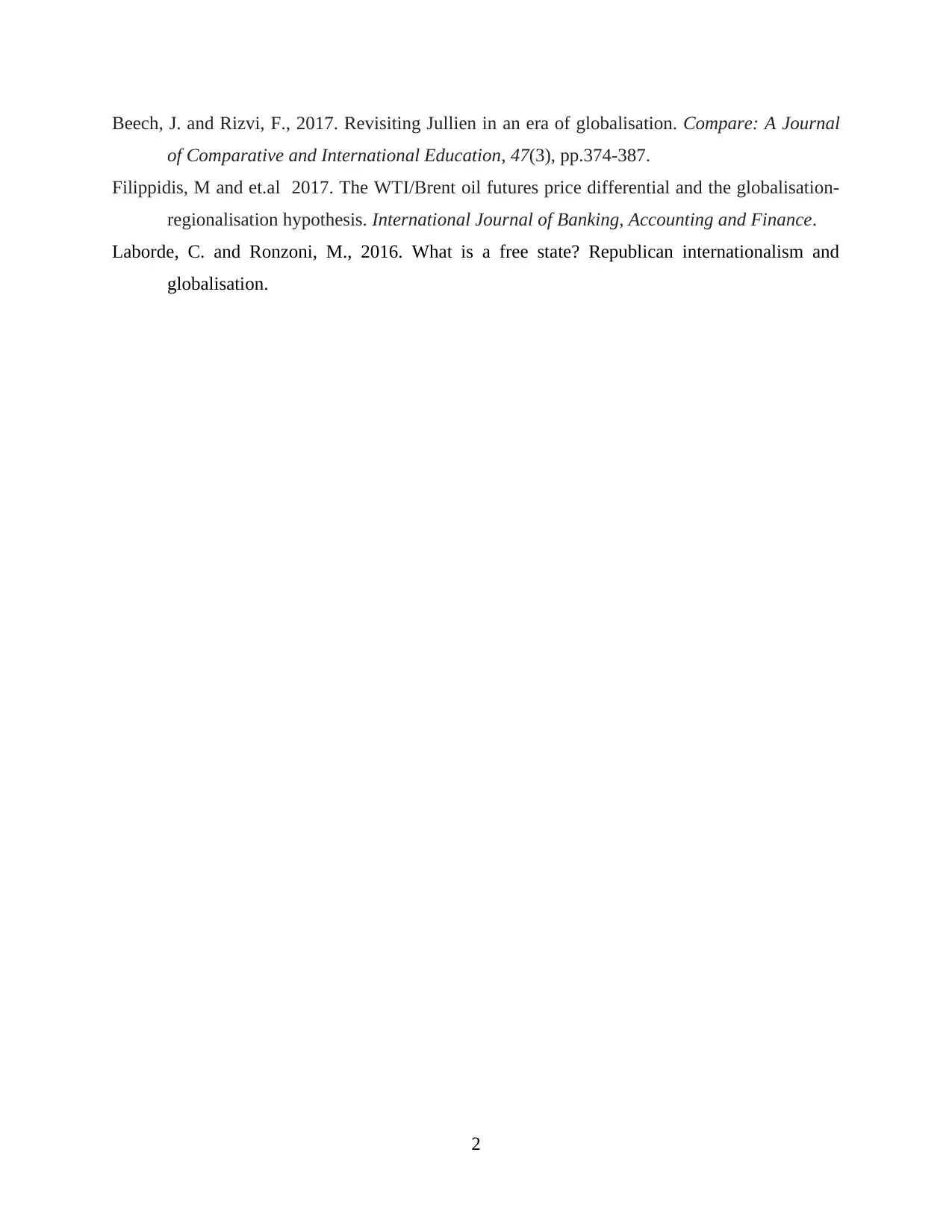
Beech, J. and Rizvi, F., 2017. Revisiting Jullien in an era of globalisation. Compare: A Journal
of Comparative and International Education, 47(3), pp.374-387.
Filippidis, M and et.al 2017. The WTI/Brent oil futures price differential and the globalisation-
regionalisation hypothesis. International Journal of Banking, Accounting and Finance.
Laborde, C. and Ronzoni, M., 2016. What is a free state? Republican internationalism and
globalisation.
2
of Comparative and International Education, 47(3), pp.374-387.
Filippidis, M and et.al 2017. The WTI/Brent oil futures price differential and the globalisation-
regionalisation hypothesis. International Journal of Banking, Accounting and Finance.
Laborde, C. and Ronzoni, M., 2016. What is a free state? Republican internationalism and
globalisation.
2
⊘ This is a preview!⊘
Do you want full access?
Subscribe today to unlock all pages.

Trusted by 1+ million students worldwide
1 out of 13
Related Documents
Your All-in-One AI-Powered Toolkit for Academic Success.
+13062052269
info@desklib.com
Available 24*7 on WhatsApp / Email
![[object Object]](/_next/static/media/star-bottom.7253800d.svg)
Unlock your academic potential
Copyright © 2020–2025 A2Z Services. All Rights Reserved. Developed and managed by ZUCOL.





